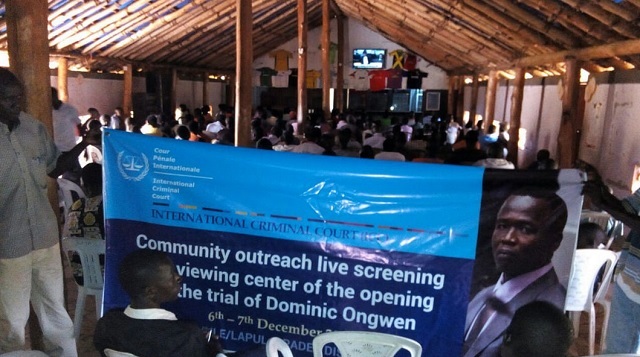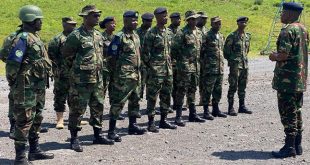
Abductions by the LRA also served a second plan. This involved the abduction of girls and young women with the express aim of forcing them to act as the wives and sex slaves of LRA commanders and fighters.
Again, there was no secrecy about the LRA’s activities in this regard. Vincent Otti’s words, in the radio program broadcast in December 2002 to which I have already made reference, were clear. He said, “I want to assure you that the girls whom we collect and send to the bush are our mothers.” He went on: “[…] We always collect the young ones who are not infected with HIV.” The only reasonable interpretation of these words is that the LRA was implementing a policy of abducting young girls for sex.
These forced wives were given no choice. They were treated as spoils of war, awarded as prizes, without any more say in the matter than if they had been inanimate objects. When they hesitated or refused to accept the sexual advances of the man to whom they had been allotted, they were savagely and repeatedly beaten. If they were suspected of trying to escape, they would be caned or murdered.
They were held for months, and in many cases years, in sexual and domestic slavery, subject to repeated rape. Many of them became pregnant, without any choice in the matter, and some gave birth to numerous children who were themselves then brought into the ranks of the LRA.
As a senior LRA commander, Dominic Ongwen benefited most from the misery of the abducted women and girls. Of his many, many forced wives, seven women have already given evidence about their personal experiences.
By way of example, the Prosecution witness with the pseudonym P-0227 has given evidence concerning her abduction. She told the Court that a little over a month after her abduction, Ongwen summoned her to his house. She was shaking with fear. He demanded sex, and she was not able to refuse. She felt that her “whole life was in his hand.” He penetrated both her vagina and her anus with his penis, by force. To quieten her, when she wept and screamed, he threatened her with his bayonet.
After the rape, Ongwen and everyone else around her, considered this witness to be his wife. She could not escape. When she was thought to have attempted to do so, she was brutally beaten. On another occasion, Dominic Ongwen ordered that she be beaten for spending time at another LRA fighter’s house. She saw the results of Ongwen’s suspicions concerning another woman whom he had taken in forced marriage. Believing her to have shown interest in another man, he ordered the child soldiers who served as his escorts to punish her with one hundred strokes of the cane.
As a result of her rape by Dominic Ongwen, the witness gave birth to a son. This was not her choice. She felt that she was not ready to bear children.
Another Prosecution witness, P-0101, who was 14 years old at the time of the crimes, gave a devastating insight into Dominic Ongwen’s behaviour towards the young girls who were placed at his mercy. She spoke both from personal experience of her rape by Ongwen and from more general observation over a period of years. She told the Court that, “…you are raped while you’re still young… Dominic was the worst when it came to young … girls … [H]e … has sex with them at a very young age.”
But, of course, Dominic Ongwen’s responsibility is far wider than simply for the crimes that he perpetrated himself. Within the Sinia brigade, Ongwen commanded structures through which the practice of abduction, forced marriage, rape, torture, slavery and sexual slavery was institutionalised. Hundreds of girls suffered these crimes at the hands of the LRA fighters to whom Dominic Ongwen distributed them.
Not only was the physical effect upon such girls and women devastating, but there was an enduring mental effect as well. For those who survived, even after their escape or release, they had to live; they still have to live, with the stigma of having been an LRA “wife”, a perversion of the true meaning of that word.
Their future hopes of re-establishing themselves in society and creating new conjugal relationships, despite the efforts of a number of organisations which work to assist and empower them, are blighted. And there is a whole category of other victims: the children born in captivity resulting from these forced marriages, who sometimes face hostility and taunts as a result of their parentage.
I want to turn lastly to Dominic Ongwen himself. One aspect of this case is the fact that not only is Ongwen alleged to be the perpetrator of these crimes, he was also a victim. He himself, so he has told the Court, was abducted from his home by an earlier generation of LRA fighters, when he was fourteen years old. He himself, therefore, must have gone through the trauma of separation from his family, brutalisation by his captors and initiation into the violence of the LRA way of life. He has been presented as a victim, rather than a perpetrator.
People following the case against Dominic Ongwen may do so with mixed emotions. They will feel horror and revulsion at what he did, but they will also feel sympathy. The evidence of many of the child victims in this case could be, in other circumstances, the story of the accused himself.
The evidence makes it plain that he could be kind. One Prosecution witness has told the Court that generally Dominic Ongwen was a good man, who would play and joke with the boys under his command and was loved by everyone. But the same witness also told the Court that at a time when she believed she was still too young to get pregnant, Ongwen had forced her to have sex with him and that she knew she would be beaten if she refused. She also told the Court that she still bore the scars on her breasts from a beating Ongwen had given her when she failed to make his bed.
The reality is that cruel men can do kind things and kind men can be cruel. A hundred percent consistency is a rare thing. And the phenomenon of the perpetrator-victim is not restricted to international courts: it is a familiar one in all criminal jurisdictions. Fatherless children in bleak inner cities face brutal and involuntary initiation ordeals into gang life, before themselves taking on a criminal lifestyle. Child abusers consistently reveal that they have been abused themselves as children.
But having suffered victimization in the past is not a justification, nor an excuse to victimise others. Each human being must be considered to be endowed with moral responsibility for their actions. And the focus of the ICC’s criminal process is not on the goodness or badness of the accused person, but on the criminal acts which he or she has committed. We are not here to deny that Mr. Ongwen was a victim in his youth. We will prove what he did, what he said, and the impact of those deeds on his many victims.
This Court will not decide his goodness or badness, nor whether he deserves sympathy, but whether he is guilty of the serious crimes committed as an adult, with which he stands charged.
Dominic Ongwen became one of the highest ranking commanders of the LRA. He did so by his enthusiastic adoption of the LRA’s violent methods and through demonstrations that he could be more active and more brutal in his methods against the population of Northern Uganda than other LRA officers.
He was commended by Joseph Kony for the attacks his troops carried out on civilians. He was held up as an example to other, less active, LRA commanders.
As a senior commander, Dominic Ongwen had complete operational control over the soldiers under his command. He could, at any time, simply have ordered that his troops march to the nearest Ugandan army barracks, lay down their arms and surrender. Alternatively, he could have taken the course that so many of the personnel under his control took, and made an individual bid for freedom, by simply deserting. After all, as the commander, he did not have to fear the brutal canings or peremptory execution which he himself ordered for unsuccessful escapees. He was often separated by several days’ or weeks’ march from any higher LRA authority. Battalion commanders in his Sinia brigade did indeed escape during this time.
Between July 2002 and December 2005, the Amnesty Commission records show that over 9,000 LRA members surrendered and received amnesty. But Dominic Ongwen did not take that course. Instead he accepted the power and authority which came with his rank and his appointment. He planned and executed operations which brought misery and death to hundreds of ordinary people, and reported the results on the radio with excitement, not regret.
One of the log books used by the UPDF to record radio contact between LRA commanders contains a description of Dominic Ongwen announcing his intention in August 2004 of – and I quote directly: “…starting to kill civilians seriously. He said right now he has already deployed squads for atrocities and very soon p[eo]ple will hear it on the radio.” (end quote)
Let me play to you short portions of a sound recording of an intercepted radio conversation between Vincent Otti, the LRA Deputy Chairman and Dominic Ongwen. Otti is asking Ongwen to finish his report on Odek, which he had begun earlier.
Despite the poor sound quality, what you have just heard is important for two reasons. Firstly it is a direct, first-hand confession by Dominic Ongwen. He can be heard admitting to the mass murder of civilians. Second, it demonstrates that, while Ongwen has no inhibitions about stating that he has killed people, he is still uncomfortable with the fact that these people are civilians even when speaking to other members of the LRA. He knows that what he has done is wrong. He does not want to use the word openly. And so twice he avoids it, the first time calling his dead civilian victims “our colleagues” and the second time, using the standard LRA jargon word: “waya.” The word means aunt, in Acholi, but it was LRA slang for civilians. I will play the clips again now, pausing after each one.
Ongwen tells Otti that he has “just been shooting our colleagues.”
Otti cannot hear clearly. The sound quality is bad. He says: “Just what.”
Ongwen repeats: “I have just come from shooting people.”
A little later in the same conversation, the subject matter comes back to these people who have been shot. Were these soldiers that Dominic Ongwen had been shooting? No.
Ongwen boasts to Otti: “Let the people wait to hear about the waya [civilians], we have shot all of them.”
The evidence shows that Dominic Ongwen was a murderer and a rapist. It shows that he commanded attacks which destroyed innocent civilians’ livelihoods. He presided over a systematic use of child soldiers and sex crimes on young girls in the units he commanded.
The circumstances in which he himself was abducted and conscripted into the LRA many years before may perhaps amount to some mitigation of sentence in the event that he is convicted of these crimes. They cannot begin to amount to a defence, or a reason not to hold him to account for the choice that he made; the choice to embrace the murderous violence used by the LRA and to make it the hallmark of operations carried out by his soldiers.
Your Honours,
The victims of Mr Ongwen’s brutal crimes have waited too long to see justice done. It is past time we deliver to them what they are owed. On the strength of the Prosecution’s case and the evidence that will be presented during the course of this trial, we hope to do just that. I thank you for your attention.
Source : Office of the Prosecutor
 The Independent Uganda: You get the Truth we Pay the Price
The Independent Uganda: You get the Truth we Pay the Price


